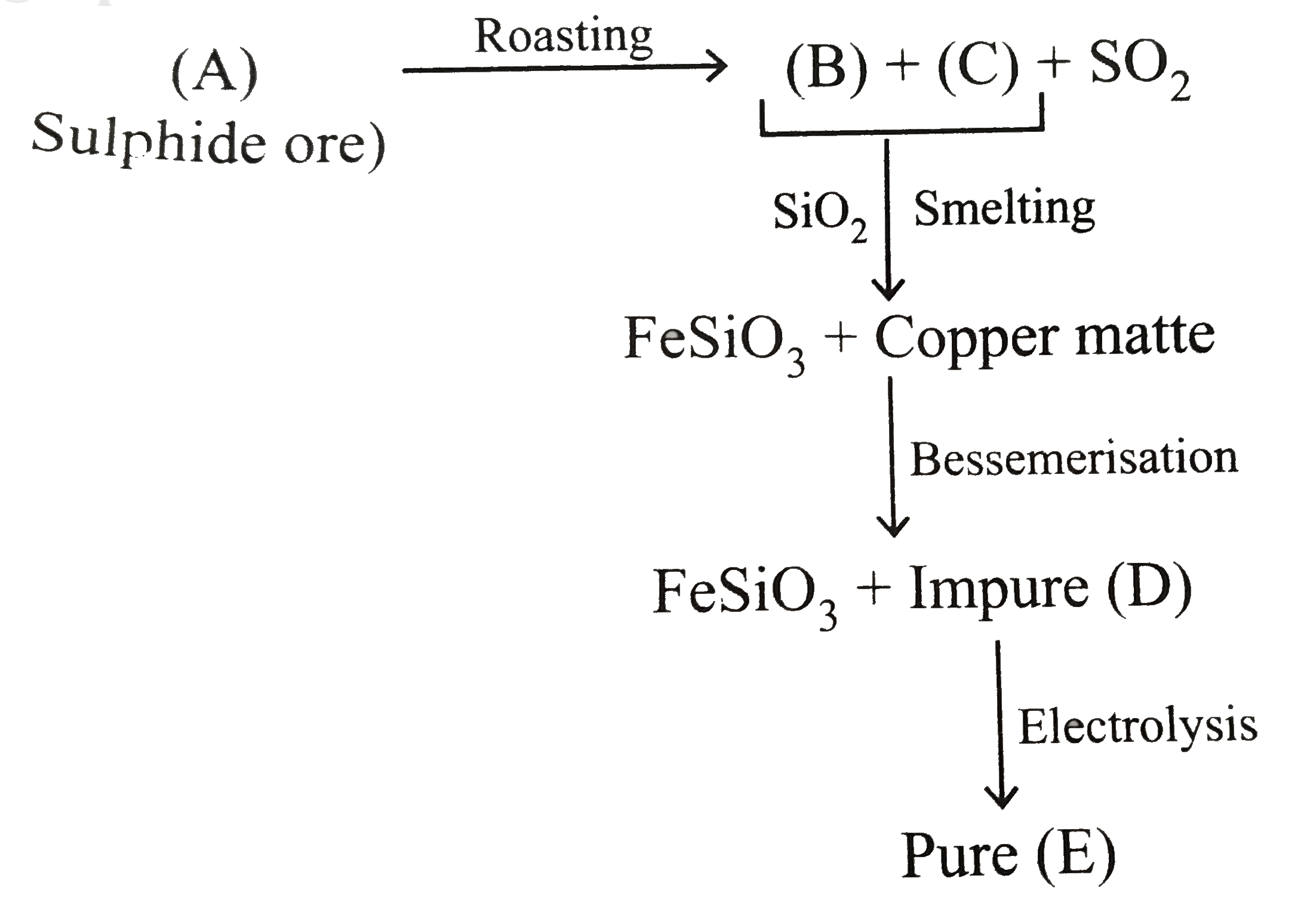
Composition of copper matte is.
(a)Cu2S
+
FeS
(small amount)
(b)
Cu2S
+
FeS
(small amount)
(c)
Cu2
+
FeSO4
(small amount)
(d)
Cu2S
+
FeO
(small amount)
Cu2S+FeS (small amount)
Cu2S+FeS (small amount)
Cu2+FeSO4 (small amount)
Cu2S+FeO (small amount)
The correct Answer is:A
2CuFeS2+O2(A)Roasting−−−−→Cu2S+2FeS+SO2
Cu2S and FeS are further partially oxidised.
2Cu2S+3O2→2Cu2O+2SO2
2FeS+3O2→2FeO+2SO2
At iron is more reactive than copper, FeS is preferentially oxidised to FeO than Cu2S to Cu2O. If at all any Cu2O is formed, it reacts with FeS to give Cu2S again.
Cu2O+FeS→Cu2S+FeO
Hence, (B) and (C) are FeO and Cu2S.
On smelting (B)+(C), i.e., heating with SiO2 (flux) and soem powdered coke, FeO combines with silica to form fusible ferrous silicate slag.
FeO+SiO2→FeSiO3Ferrous silicate (slag)
Slag being lighter, floats on the lower layer which comprises of copper matte. Copper matte mainly consists of Cu2S and some unchanged FeS.
Copper matte is separated from slag, and on electrolysis gives pure Cu metal. Hence,
Copper matte is Cu2S+FeS (small amount) .
Topper's Solved these Questions
- GENERAL PRINCIPLES AND PROCESS OF ISOLATION OF ELEMENTSBOOK - CENGAGE CHEMISTRY ENGLISHCHAPTER - GENERAL PRINCIPLES AND PROCESS OF ISOLATION OF ELEMENTSEXERCISE - Exercise (Multiple Correct)
43 Videos
- GENERAL PRINCIPLES AND PROCESS OF ISOLATION OF ELEMENTSBOOK - CENGAGE CHEMISTRY ENGLISHCHAPTER - GENERAL PRINCIPLES AND PROCESS OF ISOLATION OF ELEMENTSEXERCISE - Exercise (Single Correcttype)
106 Videos
- GENERAL PRINCIPLES AND PROCESS OF ISOLATION OF ELEMENTSBOOK - CENGAGE CHEMISTRY ENGLISHCHAPTER - GENERAL PRINCIPLES AND PROCESS OF ISOLATION OF ELEMENTSEXERCISE - Exs 1.1 (True Orfalse Statement)
19 Videos
- ELECTROCHEMISTRYBOOK - CENGAGE CHEMISTRY ENGLISHCHAPTER - ELECTROCHEMISTRYEXERCISE - Archieves Subjective
35 Videos
- GRIGNARD REAGENTS AND ORGANOMETALLIC REAGENTSBOOK - CENGAGE CHEMISTRY ENGLISHCHAPTER - GRIGNARD REAGENTS AND ORGANOMETALLIC REAGENTSEXERCISE - Exercises Archives (Linked Comprehension)
1 Videos
Similar Questions
Small amounts of P and S are carried as organic compounds
View SolutionFind the principal value of c o s e c−1(−2) .
View SolutionMenstion the values of n and l corresponding to the following orbitals.
(a) 2s (b) 2p (c ) 3d (d) 4f ( e) 3s
View SolutionIn which of the following process maximum energy is released
A) S(g)+e−→S−(g) B) O−(g)+e−→O−2(g) C) S−(g)+e−→S−2(g)
View SolutionThe area of the region of the plane bounded by max(|x|,|y|)≤1 and xy≤12 is
(a) 12+ln2 sq. units
(b) 3+ln2 sq. units
(c)314 sq. units
(d) 1+2ln2 sq. units
View SolutionFind the principal values of (1) c o s e c−1(2) and c o s e c−1(−2√3)
View SolutionThe domain of f(x)is(0,1). Then the domain of (f(ex)+f(1n|x|) is (a)(−1,e) (b). (1,e) (c).(−e,−1) (d) (−e,1)
View SolutionTwo complementary angles are in the ratio 2:3. The measure of the larger angle is (a) (b)(c)(d)(e)60(f)0(g)(h)(i) (j) (b) (k)(l)(m)(n)54(o)0(p)(q)(r) (s) (c) (d)(e)(f)(g)66(h)0(i)(j)(k) (l) (d) (m)(n)(o)(p)48(q)0(r)(s)(t) (u)
View SolutionThe sum of an angle and one third of its supplementary angle is 900. The measure of the angle is (a) (b)(c)(d)(e)135(f)0(g)(h)(i) (j) (b) (k)(l)(m)(n)120(o)0(p)(q)(r) (s) (c) (d)(e)(f)(g)60(h)0(i)(j)(k) (l) (d) (m)(n)(o)(p)45(q)0(r)(s)(t) (u)
View SolutionThe sum of an angle and half of its complementary angle is 750. The measure of the angle is (a) (b)(c)(d)(e)40(f)0(g)(h)(i) (j) (b) (k)(l)(m)(n)50(o)0(p)(q)(r) (s) (c) (d)(e)(f)(g)60(h)0(i)(j)(k) (l) (d) (m)(n)(o)(p)80(q)0(r)(s)(t) (u)
View Solution
